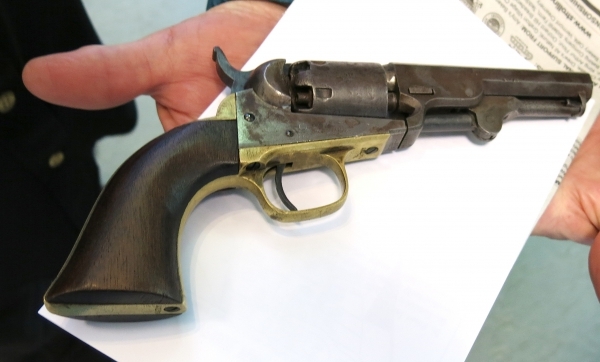BRATTLEBORO — Civil War historian Howard Coffin held a battered old pistol in his hand.
The revolver, more than a century and a half old, didn't look like much. But Coffin told an audience at the River Garden on Sunday that it was the pistol that ended the Civil War.
The story of that pistol, and the Vermonter who carried it, was one of several talks related to various aspects of the Civil War that were presented in Brattleboro to mark the 150th anniversary of the end of the Civil War.
Coffin said the pistol belonged to Capt. Charles Gould of Windham, a company commander in the Fifth Vermont Infantry Regiment. Gould's regiment was part of the First Vermont Brigade, formed in 1862. His was the only unit in the Union Army composed entirely of men from a single state that served throughout the war.
The First did not fight at Gettysburg, but the Second Vermont Brigade did, distinguishing itself on the afternoon of July 3, 1863, when three regiments from the Second, commanded by George Stannard, faced down 13,000 Confederate infantrymen, and stopped the Rebel advance.
But the war would drag on through the rest of 1863 and all of 1864. And Coffin said the First Vermont Brigade was in the thick of it at places such as the Battles of the Wilderness, Spotsylvania Court House, Cedar Creek, and Cold Harbor.
By April 1865, it was time to break the stalemate.
An accident of terrain and darkness
Just before dawn on the morning of April 2, 1865, Gen. Ulysses S. Grant massed 12,000 Union soldiers of the Army of the Potomac's Sixth Corps west of Petersburg, Va., which had been under siege by Union forces for 10 months.
The Rebels, led by Gen. Robert E. Lee, held Petersburg as the last line of the defense to prevent Grant's troops from taking the Confederate capital of Richmond.
But Coffin said First Vermont Brigade commander Lewis Addison Grant spotted a weak spot in the Confederate defenses. Because it was his idea, “the brigade was accorded the honor of leading the attack - an honor the veterans would just as soon have foregone. With the war's end obviously near, life seemed all the more precious.”
Gould's unit, Company H, would lead the attack.
As a toddler in Windham, Coffin said Gould was badly burned when he fell into a tub of boiling maple sap at his grandmother's house. Doctors said he'd never walk again.
Instead, he grew up and his daredevil nature prompted him to join the army when he was 17, against his parents' wishes. He was a month shy of his 20th birthday when he led his men into battle in Petersburg.
That morning, through an accident of terrain and darkness, Coffin said, Gould and his men found themselves separated from the main Union line, caught between the earthworks of the Rebel defenses and the fast-approaching Union forces.
Coffin said Gould was first over the top. What happened next would result in Gould being awarded the Medal of Honor, the U.S. military's highest decoration, in 1890.
According to the Medal of Honor citation, “Among the first to mount the enemy's works in the assault, Captain Gould received a serious bayonet wound in the face, was struck several times with clubbed muskets, but bravely stood his ground, and with his sword killed the man who bayoneted him.”
Gould would survive his wounds, but he lost the revolver that he held in his right hand as he led the charge.
The pistol, engraved with Gould's name, eventually ended up in a North Carolina antiques store. Coffin tracked it down and bought it. It will eventually be turned over to a Vermont museum, he said.
The Vermonters, and the rest of the Union forces, would rout Lee's defenses and by the next day, the Ninth Vermont Regiment led Union troops into Richmond.
Six days later, Lee and Grant met at the court house in Appomattox, Va., and Lee surrendered his Army of Northern Virginia.
The Civil War was over.
Dear cost in blood and treasure
The official records state that 34,238 Vermonters served in the Civil War, and 5,224 of them died. Coffin believes the number exceeds 6,000, especially since many men who died upon returning to Vermont were not counted as war dead.
On Memorial Day 1886, Coffin said Lewis Addison Grant spoke to 7,000 people at Brandon's Civil War memorial dedication, and that he concluded his speech by addressing the dear cost in blood and treasure that Vermont paid in the Civil War.
“Father and loving mother,” Grant said, “the sacrifice of your loving son has produced glorious results...The war tore the manacles of bondage from millions of people and bade them go free...
“We have helped guide our nation into the paths of peace. Let us labor to hasten on the glorious day when peace shall prevail and nations shall learn war no more. That day is coming. It shall be a day of rejoicing, the like of which has not been known since the morning stars sang together and the sons of God shouted for joy.”
Gould lived to the age of 71, and died on Dec. 5, 1916. He was buried in the Windham Center Cemetery.
